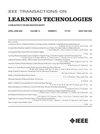Using RoblockLLy in the Classroom: Bridging the Gap in Computer Science Education Through Robotics Simulation
IF 2.9
3区 教育学
Q2 COMPUTER SCIENCE, INTERDISCIPLINARY APPLICATIONS
引用次数: 0
Abstract
RoblockLLy is an educational robotics simulator designed for primary and secondary school students, whose goal is to increase their interest in science, technology, engineering, and mathematics. In the particular case of computer science, it allows developing computational thinking skills. It has been designed with ease of use in mind. This free tool is available through a web browser and does not need a complex installation or specific hardware requirements, allowing educational robotics to be introduced to a wide range of users by working on practical projects that will help them understand key concepts of robotics and programming. The effectiveness of RoblockLLy has been validated based on motivation, usability, and user experience criteria. The tool was validated with 212 secondary school students (12–16 years old). Specifically, motivation was measured with the Intrinsic Motivation Inventory, usability with the System Usability Scale, and user experience with the User Experience Questionnaire. Generally speaking, the results demonstrate that students perceived RoblockLLy as a novel and interesting tool. The ratings for usability were predominantly positive, although a few students indicated a preference for expert assistance. The overall rating of the user experience was positive as well, yet notable differences in attitudes toward motivation and usability were observed between genders.在课堂上使用roblockly:通过机器人模拟弥合计算机科学教育的差距
roblockly是为中小学生设计的教育机器人模拟器,其目标是提高他们对科学、技术、工程和数学的兴趣。在计算机科学的特殊情况下,它允许发展计算思维技能。它在设计时就考虑到使用方便。这个免费工具可以通过web浏览器获得,不需要复杂的安装或特定的硬件要求,允许教育机器人通过实际项目介绍给广泛的用户,这将帮助他们理解机器人和编程的关键概念。roblockly的有效性已经根据动机、可用性和用户体验标准进行了验证。该工具在212名中学生(12-16岁)中进行了验证。具体来说,动机是用内在动机量表测量的,可用性是用系统可用性量表测量的,用户体验是用用户体验问卷测量的。总的来说,结果表明学生认为roblockly是一个新颖有趣的工具。可用性的评分主要是积极的,尽管一些学生表示更喜欢专家的帮助。对用户体验的总体评价也是积极的,但对动机和可用性的态度在性别之间存在显著差异。
本文章由计算机程序翻译,如有差异,请以英文原文为准。
求助全文
约1分钟内获得全文
求助全文
来源期刊

IEEE Transactions on Learning Technologies
COMPUTER SCIENCE, INTERDISCIPLINARY APPLICATIONS-
CiteScore
7.50
自引率
5.40%
发文量
82
审稿时长
>12 weeks
期刊介绍:
The IEEE Transactions on Learning Technologies covers all advances in learning technologies and their applications, including but not limited to the following topics: innovative online learning systems; intelligent tutors; educational games; simulation systems for education and training; collaborative learning tools; learning with mobile devices; wearable devices and interfaces for learning; personalized and adaptive learning systems; tools for formative and summative assessment; tools for learning analytics and educational data mining; ontologies for learning systems; standards and web services that support learning; authoring tools for learning materials; computer support for peer tutoring; learning via computer-mediated inquiry, field, and lab work; social learning techniques; social networks and infrastructures for learning and knowledge sharing; and creation and management of learning objects.
 求助内容:
求助内容: 应助结果提醒方式:
应助结果提醒方式:


